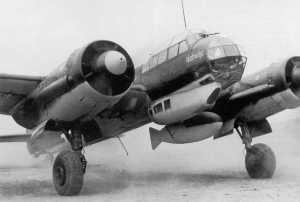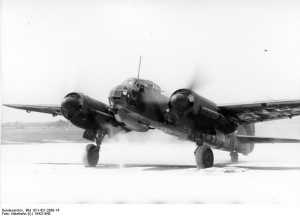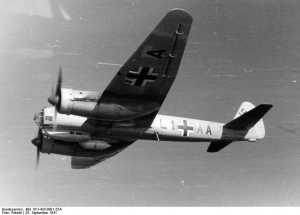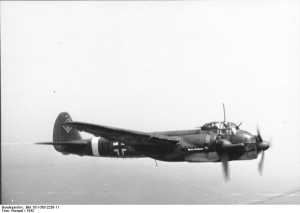Junkers Ju 88
Germany's most effective night fighter in WW2
By Stephen Sherman, Dec. 2008. Updated July 7, 2011.
Versatile. That sums up the Junkers Ju 88 in one word. During WW2, this twin engine aircraft was adapted for: dive-bombing, level-bombing, ground attack, night-fighting, torpedo dropping, and reconnaissance.
Originally developed in 1936 as a civil aircraft, the first Ju 88s were modified into bombers: the A-1 version. Perforce, these were heavier and slower than the prototypes, but were ready for service at the start of the war. Also carrying a large bombload, the A-1 lacked strong defensive armament. In the A-4, the bombload was increased to 3,000kg (6,614 lb.) and defensive weaponry improved. The many later variations of the Ju 88 were developed from the A-4.
The Ju 88 airframe was structurally strong and had capacity for large fuel and bomb loads. While modified many times, it's performance was never degraded as seriously as the Dornier and Heinkel bombers. With its BMW radial and Jumo 213 engines, the later versions of the Ju 88 were almost as fast as contemporary fighters and the plane could handle the violent aerobatics needed in combat. Among the distinctive features of the Ju 88 were the compact crew compartment, purposely designed that way for crew morale, and the large single struts of the main landing gear. When retracted, the wheels turned 90 degrees and tucked into the engine nacelles.
In the first few years of the war, about 2,000 Ju 88s were built annually, mostly A-4s and A-5s. Later development focused on the S series (bomber types which were better streamlined in hopes of improving performance, as traditional Luftwaffe bombers finally were seen to be hopelessly slow) and on the G series, which served as a night fighter.
Altogether, production of the Ju 88 reached nearly 15,000 airplanes: more than 10,000 bombers and 4,000 fighters.
Bomber Variants
Ju 88A
There were 17 of these, A-1 through A-17, including variants for specialized roles such as dive-bombing, anti-shipping strike, long range reconnaissance, and training. The A-4 was the most common of these. It was developed after the Battle of Britain and incorporated changes as a result of that experience: it had longer wings, a more powerful engine (the Jumo 211J), increased bombload, and better defensive armament.
Ju 88B
This followed a separate line of development and became the Ju 188.
Ju 88D
Over 1,800 of these strategic reconnaissance aircraft were built.
Ju 88S
The S series differed in their powerplants: the S-1 using the 1,700 hp BMW 801G, the S-2 the 1,810 hp BMW 801TJ, and the S-3 the 1,740 hp Jumo 213E-1. Otherwise, these were basically similar to each other, and differed from other early Ju 88s in having a rounded glazed nose. In the interest of speed, they were less heavily armed, carried a smaller bomb load, and were better streamlined.
Ju 88T
Photo-reconnaissance versions of the S series.
Fighter Variants
Ju 88C
At the same time as they were working on the A series, Junkers pursued the development of the same airframe as a heavy fighter; this became the C series. This featured a solid nose, with three machine guns and a 20mm cannon firing forward, as well as a single aft-firing machine gun. Later C series models added more cannon in the nose and the more powerful Jumo 211J engine.
Ju 88G
The G series of the Ju 88, a dedicated night-fighter, was probably the best of that breed, but other demands on Ju 88 production limited the number produced, and the Bf 110 carried the brunt of the nachtflieger operations.
Pictures and Model Kits
Some very advanced models of the Ju 88 here. The models shown include many different types of radars installed, and can be studied for that purpose. Also, the models clearly show the solid nose of the fighter variants, as opposed to the multi-panel glazed nose shown in the photo above left.
For Sale
The market for WW2 airplanes is quite small, especially as the supply is very limited. Many original aircraft are in the hands of museums or airshow operators, and turnover is rare. When 'warbirds,' as they are called, do come on the market, Controller.com and Global Plane Search usually have them listed. Obviously, they are very expensive. For example, P-51 Mustangs are offered for $800,000 to $2,000,000.
Engines
The Jumo 211 and 213, used extensively in the Ju 88, were 12-cylinder, in-line, inverted vee engines. The 211 C generated 986 hp at take-off. The 213 added two features, a pressurized cooling system that required considerably less cooling fluid that allowed the engine to be built smaller and lighter, and a number of improvements that allowed it to run at higher RPM. These boosted power to 1,750 hp and made the 213 one of the most sought-after engine designs in the late-war era.
The BMW 801 engines, used in the S-1, was a radial engine. It was highly unusual to switch between radial and in-line engines in variants of the same airframe.
There were two main types of engines used in World War Two airplanes: radial and in-line.
An in-line engine refers to an internal combustion engine with banks rather than rows of cylinders, including straight and V engines. Usually found in 4- and 6-cylinder configurations, the straight engine has all cylinders aligned in one line, with no or only minimal offset. The radial engine is an internal combustion engine in which the cylinders are arranged around a central crankshaft like the spokes on a wheel. Airplanes with radial engines have a distinctive, large, round nose. Radial engines were very common in aircraft engines between 1920 and 1950. The cylinders are connected to the crankshaft with a master-and-articulating-rod assembly.




